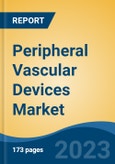Speak directly to the analyst to clarify any post sales queries you may have.
10% Free customizationThis report comes with 10% free customization, enabling you to add data that meets your specific business needs.
Key Market Drivers
Rising Prevalence of Peripheral Artery Disease (PAD) and Diabetes
A major driver of the peripheral vascular devices market is the escalating incidence of Peripheral Artery Disease (PAD) and diabetes globally. PAD affects over 15% of individuals aged 60+, and more than 35% of diabetic patients also develop PAD, highlighting the urgent need for vascular intervention tools. According to the World Health Organization (WHO), cardiovascular diseases, including PAD, remain the leading cause of death worldwide. Diabetes exacerbates vascular issues by accelerating atherosclerosis, which narrows arteries and restricts blood flow, thereby increasing the demand for medical devices like stents, angioplasty balloons, and catheters. Additionally, global public health campaigns aimed at controlling diabetes and its complications indirectly support market growth.Key Market Challenges
Stringent Regulatory Requirements
The stringent regulatory environment represents a key hurdle for manufacturers of peripheral vascular devices. Authorities like the FDA and EMA mandate extensive clinical trials and safety checks, which can delay product releases and inflate development costs. Furthermore, inconsistencies in regulatory standards across countries complicate international market entry, requiring companies to invest heavily in compliance efforts. This complexity may impede innovation and restrict access to cutting-edge devices in some regions. Although initiatives to harmonize global standards are in progress, regulatory disparity remains a significant barrier to market expansion.Key Market Trends
Technological Advancements in Peripheral Vascular Devices
The peripheral vascular devices market is witnessing rapid transformation through technological advancements. Innovations such as drug-eluting stents, which prevent arterial re-narrowing, have significantly improved clinical outcomes. Bioresorbable scaffolds - accounting for nearly 20% of newly developed vascular devices - provide temporary vascular support before dissolving, thereby minimizing long-term risks. Additionally, the integration of artificial intelligence and machine learning is enhancing diagnostic precision and enabling personalized treatment planning. These developments contribute to more effective, less invasive procedures, aligning with the global healthcare shift toward minimally invasive interventions. Regulatory support and increased R&D funding are further propelling these advancements.Key Market Players
- Abbott Laboratories
- AngioScore Inc.
- Edward Lifesciences Corporation
- Medtronic Inc
- St. Jude Medical
- Teleflex Medical
- Volcano Corporation
- Boston Scientific Corporation
- Teleflex Medical
- Cook Group Inc.
Report Scope:
In this report, Global Peripheral Vascular Devices market has been segmented into the following categories, in addition to the industry trends which have also been detailed below:Peripheral Vascular Devices Market, By Type:
- Peripheral Stents
- PTA Balloons
- Catheters
- Endovascular Aneurysm Repair Stent Grafts
- Plaque Modification Devices
- Peripheral Accessories
- Inferior Vena Cava Filters
- Hemodynamic Flow Alteration Devices
Peripheral Vascular Devices Market, By End User:
- Hospitals
- Clinics
- Ambulatory Surgical Centers
Peripheral Vascular Devices Market, By Region:
- North America
- United States
- Canada
- Mexico
- Europe
- France
- Germany
- United Kingdom
- Italy
- Spain
- Asia Pacific
- China
- India
- Japan
- South Korea
- Australia
- South America
- Brazil
- Argentina
- Colombia
- Middle East & Africa
- South Africa
- Saudi Arabia
- UAE
Competitive Landscape
Company Profiles: Detailed analysis of the major companies present in the Global Peripheral Vascular Devices Market.Available Customizations:
With the given market data, the publisher offers customizations according to a company's specific needs. The following customization options are available for the report.Company Information
- Detailed analysis and profiling of additional market players (up to five).
This product will be delivered within 1-3 business days.
Table of Contents
Companies Mentioned
- Abbott Laboratories
- AngioScore Inc.
- Edward Lifesciences Corporation
- Medtronic Inc
- St. Jude Medical
- Teleflex Medical
- Volcano Corporation
- Boston Scientific Corporation
- Teleflex Medical
- Cook Group Inc.
Table Information
| Report Attribute | Details |
|---|---|
| No. of Pages | 188 |
| Published | May 2025 |
| Forecast Period | 2024 - 2030 |
| Estimated Market Value ( USD | $ 10.58 Billion |
| Forecasted Market Value ( USD | $ 15.74 Billion |
| Compound Annual Growth Rate | 6.8% |
| Regions Covered | Global |
| No. of Companies Mentioned | 10 |









